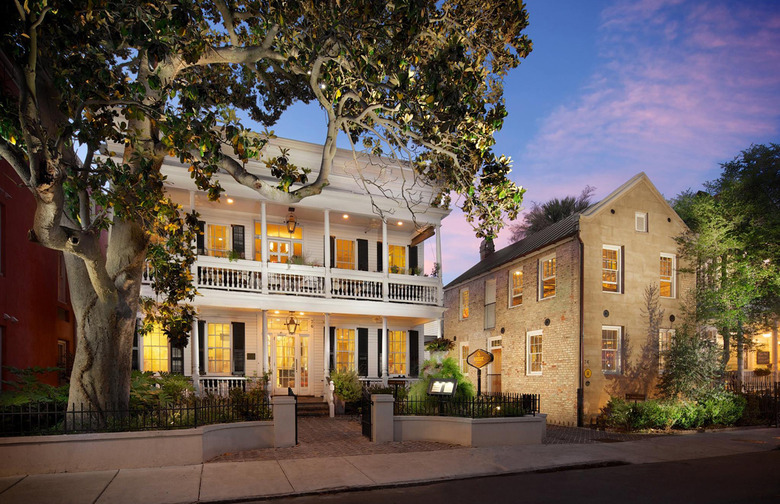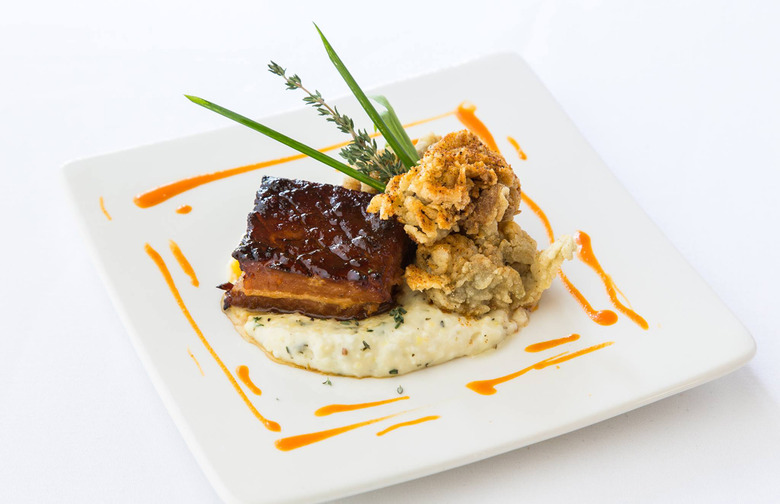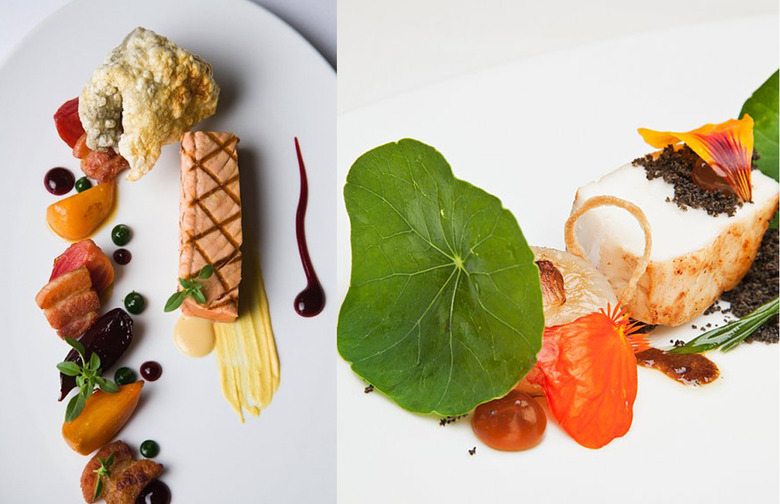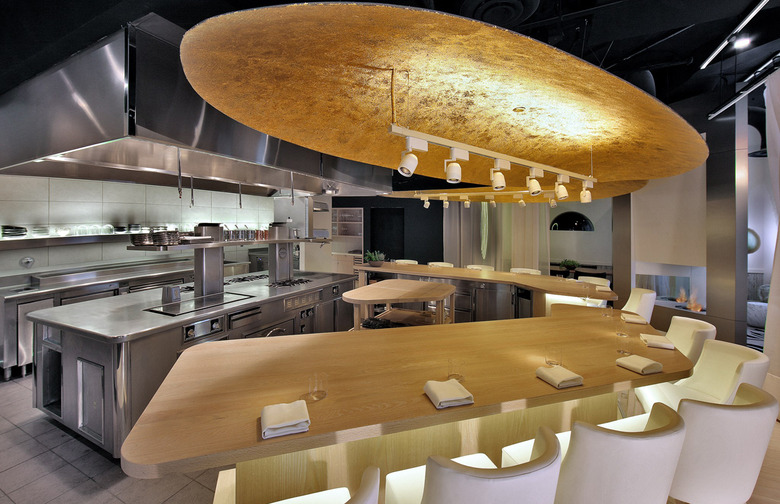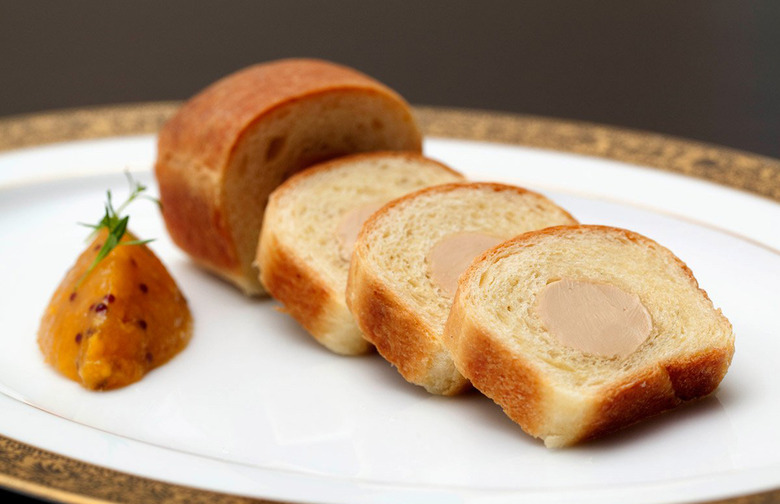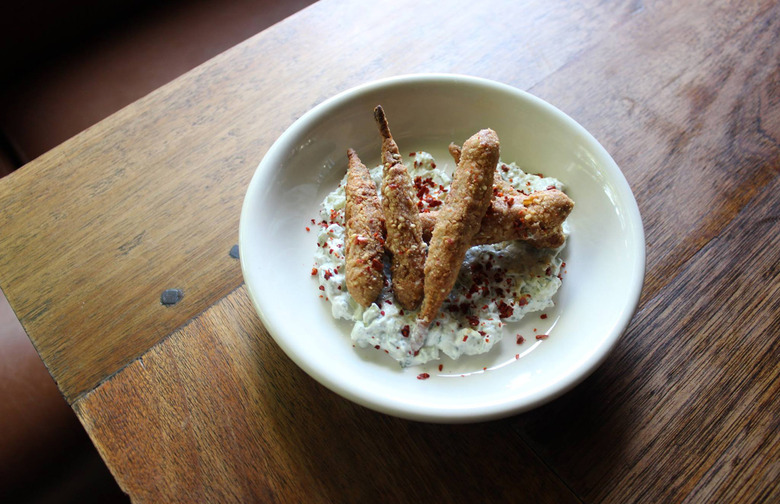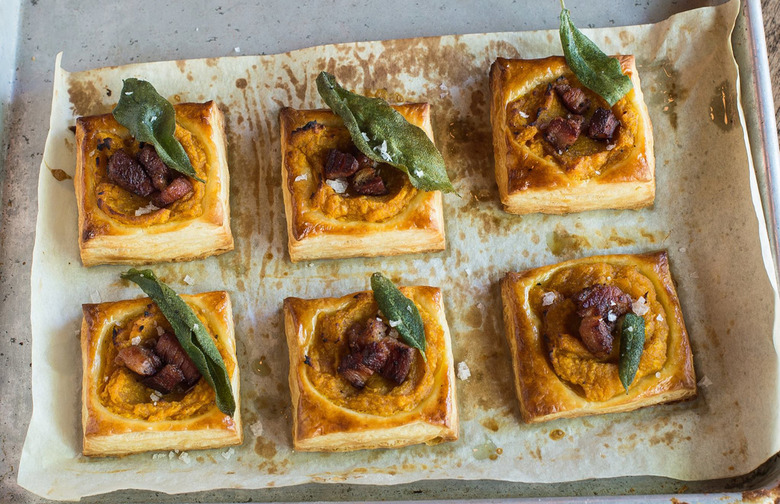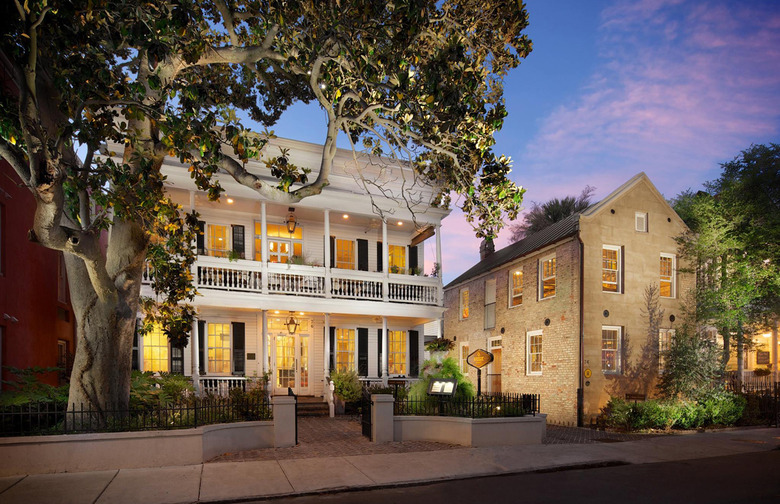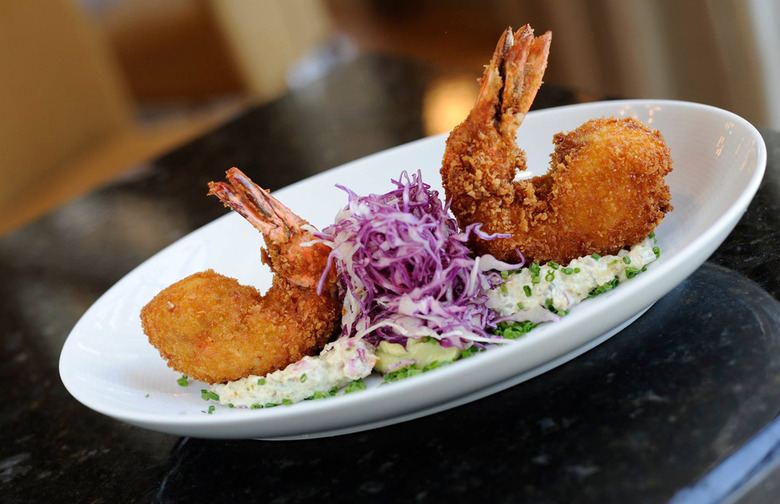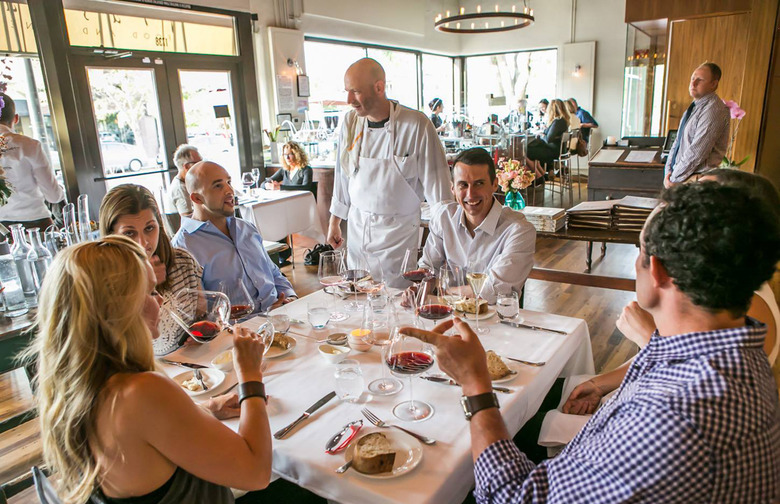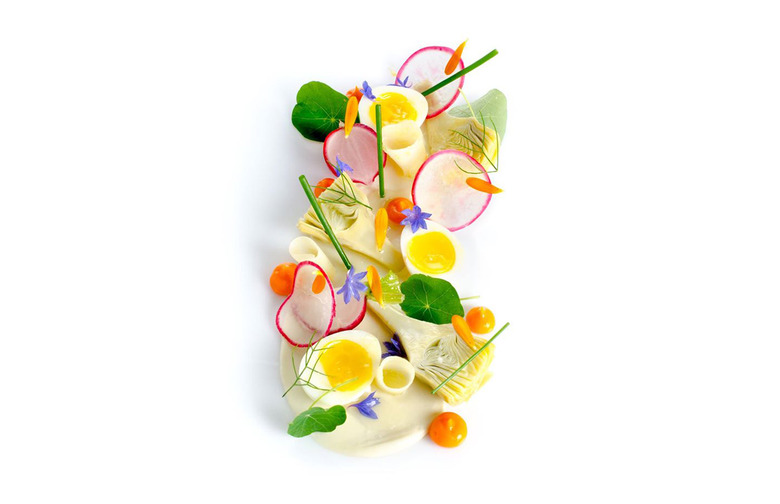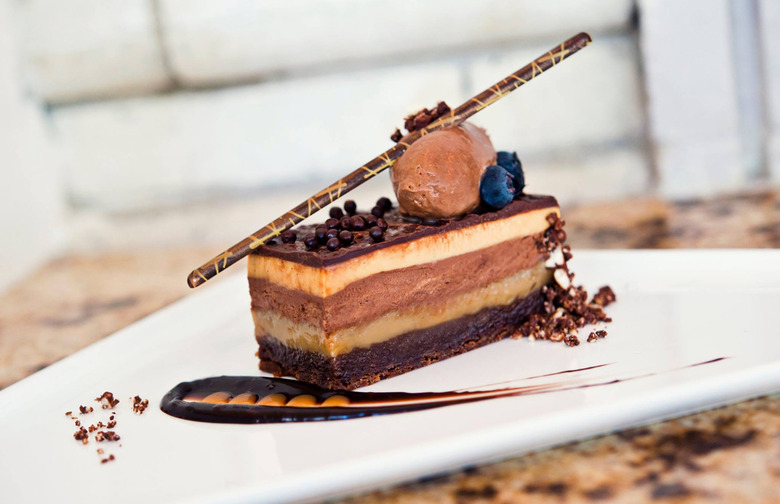21 Tax-Day Blowouts In 21 American Cities
We may receive a commission on purchases made from links.
21 Tax-Day Blowouts in 21 American Cities
Tax season is a mixed blessing: For some it's a whole lot of work only to learn that you owe the government money, but for others it's a reason to celebrate after your rebate check arrives. For the lucky ones in the latter camp, we're helping you figure out the best restaurants at which to spend your tax refund in 21 cities, should you decide to take that route.
New York: Le Bernardin
This elegant seafood restaurant, headed by chef Eric Ripert, has topped many "best of" lists and has several accolades under its belt, including repeat four-star reviews from The New York Times (the first of them written only a few months after its opening), perfect food ratings in the Zagat guide from 2011 to 2013, and more James Beard Awards than any other restaurant in New York City. Ripert is an artist working with impeccable raw materials. The four-course, $140 prix fixe dinner features a list of delicacies from the sea, ranging from "almost raw" first courses to "lightly cooked" mains to (if you insist) "upon request" dishes like duck, lamb, and filet mignon. A seven course, $180 Le Bernardin tasting and an eight-course, $215 Chef's Tasting are also available. Eat in Le Bernardin's recently revamped modern dining room against a backdrop of painted waves and enjoy dishes like layers of thinly pounded yellowfin tuna, Iberico ham "chutney," sea beans, and lemon olive oil; warm king fish sashimi with caviar in a light marinière broth; grilled escolar and seared wagyu beef with fresh kimchi, Asian pear, and soy-citrus emulsion.
Los Angeles: Providence
Los Angeles is a city that thrives on food trucks and pop-ups, but sometimes a no-holds-barred fine dining experience is called for. Chef Michael Cimarusti, who opened this upscale eatery with co-owner Donato Poto in 2005 on the southern edge of Hollywood, serves market tasting menus as well as an à la carte listing of carefully selected seafood from both coasts and beyond, prepared with great originality. He holds two Michelin stars for his efforts. Who else offers geoduck with radish and wasabi; Australian spanner crab with Royal Osetra caviar; or A5 wagyu with sweet potato, aged vinegar, and Parmigiano-Reggiano? At $115 for the four-course (or $180 for seven courses) signature and seasonal menu and $220 for the 12-course chef's menu, Providence isn't for diners on a budget. The impeccable service combined with the quality of the seafood and the lapidary perfection of the plates Cimarusti sends out makes it clear that this restaurant has few equals.
Las Vegas: L’Atelier de Joel Robuchon
The cooking is simply exquisite in this opulently furnished dining room in the MGM Grand Hotel & Casino, currently the only three Michelin-star restaurant in the city. As the first restaurant opened in America by the famed, award-winning Robuchon, widely considered the greatest of modern French chefs, Joël Robuchon maintains the highest standards under the guidance of chef Steve Benjamin. Everything is impeccable, from its superb service and impressive (and impressively pricey) wine list to such finely crafted dishes as beef châteaubriand and foie gras "Rossini" style with aged Port and carpaccio of foie gras and potatoes covered with black truffle shavings. The 16-course tasting menu is a truly memorable experience — as well it ought to be at $445 a head, wine not included.
Washington: Minibar
They really have tried to make it easier on everyone, but getting into minibar, where protean chef José Andrés channels Spanish avant-garde cuisine, is still difficult. The restaurant now accepts reservations on a seasonal basis (in three-month periods), with each season opening one month in advance. But you still need to send them an email a couple of months ahead of time and keep your fingers crossed. When you do get what is still essentially the reservation of a lifetime (let's be honest here), you'll perch at one of two counters that overlook the kitchen, which The Washington Post critic Tom Sietsema called "suggestive of an operating theater when you factor in the chefs in their whites, bending over dishes manipulated by tweezers, tongs, liquid nitrogen and cloches galore." Expect a "molecular gastronomy" experience executed by executive sous-chef Johnny Spero and filled with culinary hat tricks — think edible rubber duckies, popcorn that smokes in your mouth, and a churro made with veal tendon. Even with a price tag of $250 for 25 to 30 (mini) courses, it's a steal of a deal. The imaginative cuisine displayed at minibar scored chef José Andrés a 2011 James Beard Outstanding Chef Award. In 2013, Andrés opened the adjoining barmini, his "culinary cocktail lab," where more than 100 adventuresome cocktail creations adorn the menu. According to Sietsema, it is "home to some of the most fascinating liquids this city has ever sipped."
Chicago: Next
Nearly six years after opening, chef Grant Achatz's groundbreaking restaurant Nextseems as if it has always been part of the culinary avant-garde — ironic for a restaurant whose prix fixe concept changes every four months. There's nothing blasé about Next. You never know what's going to be placed before you by Achatz and his (soon-to-be-departing) star executive chef Dave Beran — it could be anything from chicken liquid croquettes (elBulli menu) to the world's best mac and cheese (Childhood menu). Well, technically, it will be neither, given that they're from past menus and menus don't repeat. But you get the idea. Next has paid homage to legendary French chef Auguste Escoffier; then it was a futuristic Thai menu; followed by Childhood; an homage to the now-closed elBulli; explorations of Sicily and Kyoto; "The Hunt," a vegan menu; tributes to the Bocuse d'Or, the Chicago Steakhouse, the restaurant Trio where Achatz first set out on his own; an interpretation of modern Chinese; Bistro; Tapas; Terroir; and currently, The Alps, focusing on the cuisine of the mountainous regions of Austria, France, Germany, Italy, Lichtenstein, and Switzerland. Coming up? "Tour of South America" and "The French Laundry."
Whatever it is, Next's food is inventive and exciting without being gimmicky; likewise, the service is flawless without being fawning. But good luck getting in. There's an online reservation system for buying "tickets," but you'll be joining some 20,000 (yes, 20,000) other folks just as desperate and committed to scoring a table. If you get into Achatz's next-door cocktail lounge, The Aviary, in itself no small feat, there's a tiny chance that you might get a late table at Next. Or check Next's Facebook page. Most nights, they hold a table or two and sell them there. The catch? You have to be in Chicago already.
New Orleans: Commander’s Palace
A slice of New Orleans dining history — it opened in 1880 — this culinary landmark has long been collecting accolades for everything from its service to its wine list and of course its "haute Creole" cuisine. Two of its alumni, it might be noted, are Paul Prudhomme and Emeril Lagasse — but with chef Tory McPhail at the ovens for over a decade,Commander's Palace is still going strong. Come hungry and ready for such dishes as the sous-vide five-hour egg with roasted shiitakes, spiced truffle, and chicken cracklins; cast-iron seared foie gras with Bocage honeycomb, cornbread, pickled strawberries, and candied pistachios; or tangerine sorbet with a vanilla pastry cream, candied blood oranges, banana olive oil cake, tarragon, and lava salt.
Boston: O Ya
Chef Tim Cushman brings innovative sushi and related new-Japanese fare to his menu with imagination and flair, accompanied by a large choice of excellent sake and wine, in an understated dining room whose simplicity belies the complexity of flavors on the plate. Cushman won the 2012 James Beard Award for Best Chef: Northeast. At this North End sanctuary, you can expect to enjoy dishes like hamachi with spicy banana pepper mousse; bluefin maguro with caramelized onions, foie gras ponzu, and crunchy gobo; and Okinawan braised pork with Boston baked heirloom rice beans, house-made kimchi, and soy maple. For a truly unforgettable O Ya experience, try to get a seat at the counter to watch the delicious food being created before you in what is definitely one of America's best sushi restaurants. And with a second sushi outpost (as well as a new Mediterranean-themed place, Covina) now open in New York, Cushman is sharing the love.
Dallas: Fearing’s
Located in The Ritz-Carlton, Dallas,Fearing's features modern Southwestern-American cuisine with a farm-to-table approach. Indeed, along with Stephen Pyles and Daily Meal Council member Robert Del Grande, chef Dean Fearing (also a member of The Daily Meal Council) kind of wrote the book on modern Texan cooking (one of his latest cookbooks is literally called The Texas Food Bible). What does "modern Southwestern-American cuisine" mean? Barbecued shrimp taco with mango and pickled red onion; barbecued short rib enchilada with queso fundido; mesquite-grilled, bone-in ribeye with West Texas mop sauce; and "Texas carpaccio," Yoakum wagyu beef and butter-poached Gulf prawn with Texas olive oil, Grana Padano, crispy capers, and pickled golden beets. With many dining venues on-site, diners can choose from anything from the outdoor patio to the more upscale Gallery. If you're dining chef-side in Dean's Kitchen, or at the Chef's Table, look for the ebullient chef; he's almost always present. And make sure to order his signature tortilla soup.
Philadelphia: Zahav
Modern Israeli in Philadelphia? What does that entail? A melting pot of Middle Eastern and Central European cuisines, interwoven with a fine hand to create a feast of flavors by chef–owner Michael Solomonov (born in an Israeli town south of Tel Aviv called G'nei Yehuda, and raised in Pittsburgh). Settle into the warmly lit casual dining room at Zahav ("gold" in Hebrew) and start by ordering the hummus with house-baked laffa flatbread or warm Turkish hummus with butter and grilled garlic. If you're in the mood for small plates, Zahav offers crispy grape leaves with ground beef and tomato; grilled duck hearts with pickled green tomatoes, green matbucha (a Moroccan sauce of tomatoes and peppers), and shabazi (a fiery Yemeni spice blend) onion rings; and crispy haloumi cheese with dates, pickled onion, walnuts, and Turkish Urfa chile flakes, among other dishes. Move on to the duck leg kebab with pistachio pilaf, pickled onions, and fig jam; kofte (ground beef and lamb) with peppers, carrots, and flageolet beans; and chicken shishlik and root vegetable tagine with Moroccan couscous and pickled mushrooms. Israeli Goldstar beer, imaginative cocktails, and one of the largest arrays of boutique Israeli wines outside of Israel complete the picture.
San Francisco: Restaurant Gary Danko
Gary Danko, whose classical training focuses on French, Mediterranean, and regional American cooking, has received accolades from the likes of the James Beard Foundation, Michelin, Esquire, and Zagat since he opened his eponymous San Francisco wharf-area 75-seat restaurant in 1995. Choose from the three-, four-, or five-course prix fixe menus ($83, $101, and $119, respectively) and prepare for dishes like glazed oysters with Ossetra caviar, salsify, and lettuce cream; risotto with rock shrimp, Dungeness crab, shimeji mushrooms, and roasted butternut squash; and roasted quail stuffed with mushroom ragout, leeks, quinoa, and foie gras with fingerlings and porcini cream. At Gary Danko, everything is expertly executed and everything has a purpose and place.
Portland, Ore.: Beast
Much of the charm at Beast, apart from that provided by the wide-ranging modern American menu (need we add that it's local and sustainable in nature?), comes from family-style dinners served in an intimate atmosphere not much bigger than four or five of Portland's famed food carts. Chef–owner Naomi Pomeroy accepts just enough reservations for two six-course dinner seatings (6 p.m. and 8:45 p.m.) Wednesday through Saturday, as well as two four-course brunch services and one dinner service every Sunday. Patrons dine at a pair of communal tables (the restaurant seats just 24), where they are served the prix fixe menu of the day ("substitutions politely declined"). The particulars change weekly (the menu for the upcoming week is posted each Tuesday), but, just as an illustration of the range and imagination here, the house charcuterie plate might include steak tartare with quail egg, foie gras bon bon with peanut shortbread, Calabrian chile pork sausage, and pork and duck pâté with green garlic.
Those lucky enough to snag a seat at the tables are sure to be treated like family (the best spot in the house, at the corner of the prep table in the center of the kitchen, only seats two). Those unable to get in can at least now go across the street to dull the pain at Expatriate, the cocktail lounge Pomeroy opened in 2013, where they can choose from a small menu divided into Biggie Smalls (think shrimp toast and James Beard's onion and butter sandwich), Salad Days (samosa chaat and a "very spicy cucumber salad"), and Hungrier (tempura cod sandwich, Burmese coconut noodles, and Korean fried game hen).
Charleston: Husk
The Daily Meal's 2014 American Chef of the Year, Sean Brock, very well might be the ruling king of Southern cuisine, which makes his Charleston restaurant Husk his throne. Named 2011's Best New Restaurant in America by Bon Appétit, Husk, located right in the heart ofCharleston's beautiful historic downtown (where Brock also runs McCrady's), celebrates heirloom indigenous Southern products like no other restaurant can: If it's not Southern, they won't cook with it, not even olive oil. But that strict rule doesn't hinder the restaurant at all; in fact, it's the best thing about it. Just try the slow-smoked sweet-and-sour Tennessee pork ribs; Cheddar pimento cheese with house-made benne (sesame) crackers and crispy country ham; Southern-fried chicken skins with hot sauce, honey, and scallions; and Kentuckyaki pig's ear lettuce wraps, and you'll agree. And if it's more convenient, a second Husk outpost opened in Nashville in 2013.
Birmingham: Highlands Bar & Grill
This legendary French-inspired restaurant was focusing on local and sustainable ingredients before anyone coined the phrase "locavore." Highlands Bar & Grill put the Birmingham dining scene on the map when it opened in 1982, and chef and co-owner Frank Stitt, a member of The Daily Meal Council (who runs it with his wife Pardis) has already been inducted into the James Beard Foundation's Who's Who of Food & Beverage. The restaurant has been nominated for Outstanding Restaurant seven times. What to expect from a meal at Highlands? It's sometimes best to hear it straight from the source: "We serve a daily changing menu informed by classic French technique, incorporating the foods of our Southern region. We love the ever-changing basket that each harvest allows, from the first springtime shad roe to the blue-green live and kickin' soft shell crabs that arrive a few weeks later. Summer's shell beans, tomatoes, okra, and watermelon bring a smile. The cooler weather game of venison and quail, root vegetables, and greens creates sustenance. Our dishes are prepared with respect and restraint to allow each ingredient's inherent goodness to shine through."
Orlando: Norman’s
Known as the founding father of New World cuisine, chef Norman Van Aken — a member of The Daily Meal Council — is acclaimed for his fusion of Latin, Caribbean, and Asian flavors using traditional European techniques. At Norman's in the Ritz-Carlton Orlando, guests can eat in the opulent dining room or on the restaurant's outdoor terrace that overlooks the hotel's lake, 18-hole Greg Norman-designed golf course, and lush gardens. (Norman's was ranked No. 37 on The Daily Meal's list of the Best Hotel Restaurants Around the World.) The menu changes according to availability of seasonal ingredients; the $110 six-course tasting menu is currently featuring dishes including Thai-barbecued Lake Meadows poussin with warm ginger broth, Florida cobia with huitlacoche sponge cake, and smoked American bison with Okinawa sweet potato.
Nashville: The Catbird Seat
One of this list's more original restaurants, The Catbird Seat is an informal, 22-seat, U-shaped counter only open Wednesday through Saturday. Executive chef Ryan Poli (who took over for Noma vet Trevor Moran in January) is at the center of the action, preparing meals for watchful guests. Offerings change daily, there's no set menu, and diners don't know what to expect until they arrive. By all accounts, Poli hasn't missed a beat, imbuing the menu with a little Japanese influence (think wakame bucatini with yuzu kosho and scallop jerky; sea urchin osetra caviar squash tart; and Bear Creek Farms strip loin with umami crust, shiso, and eggplant). The multi-course meal takes more than two hours to play out, during which guests are encouraged to interact with the chef and discuss the meal being prepared. One thing is certain: Guests are in for a unique dining experience featuring only the freshest seasonal ingredients.
Boulder: Frasca Food & Wine
In the Friuli region of northeastern Italy, a frasca is a roadside farm restaurant, serving simple regional food. Frasca Food & Wine captures the spirit of these venues, while also championing the vast diversity of Colorado's unique culinary resources. Owners Bobby Stuckey and Lachlan Mackinnon-Patterson have created a warm and inviting space that can accommodate an impromptu dinner or an evening of fine dining. They offer a unique menu that includes salumi and cheeses along with entrées like Broken Arrow Ranch quail; gnocchi with Buckner Farm lamb sausage and broccolini; and raviolo of veal ossobuco, bone marrow, cipollini onion, and salsify. Just be sure that you don't miss the frico caldo, a crispy pancake of potatoes, onions, and Piave cheese — a Friulian specialty. Stuckey and Mackinnon-Patterson have a new restaurant in the works, slated to open in Denver by the end of the year, and it's one of the year's most anticipated openings.
Portland, Maine: Fore Street
Fore Street's wood-roasted specialties have been bringing diners in steadily since 1996. Locally harvested mussels, diver scallops, turnspit-roasted chicken and pork loin, marinated hanger steak, and other basics, accompanied by vegetables grown or foraged from nearby farms and fields, are the staples of the seasonally changing menu here. Fore Street is all about hearth, rustic charm, and a lack of artifice. The open kitchen center stage fascinates, its chefs behind a vast butcher block working the brick oven as open flames lick the meat that turns on a rotisserie, embers flying. Co-owner and chef Sam Hayward was a pioneer in locally derived, simply cooked restaurant fare at Fore Street. While this farm-to-table location brings the freshest menu to the north side of town, Hayward's Portland restaurant family has grown to include Street & Company,Standard Baking Company, and Scales on the waterfront, which opened in January.
Seattle: Canlis
Canlis is a true Pacific Northwest landmark. It's been open since 1950, serving fresh, seasonal dishes that are more polished than cutting-edge in a rustic-modern space whose use of native wood and stone evokes forests and streams. Canlis was revolutionary when it opened due to its stunning architecture (Roland Terry and Pete Wimberley collaborated on an original design meant to echo Frank Lloyd Wright) and trailblazing menu of upscale Northwest cuisine (which founder Peter Canlis essentially invented), and it's still blazing new trails while keeping the classics, such as the famous Canlis salad (romaine, bacon, mint, oregano, and Romano with a dressing of lemon, olive oil, and coddled egg), on the menu.
The restaurant's onetime chef Jason Franey, who left two years ago to take over the kitchen at Restaurant 1883 in Monterey, called his cooking at Canlis "Comfort Geek" cuisine, defining that as "pertaining to a style of cuisine, namely, that which uses modern technique without drawing too much attention to itself or alienating the diner." That idea seems to have remained in place with new chef Brady Williams at the helm (who came over from Roberta's in Brooklyn last April), with a menu offering both classic and contemporary dishes, among them wagyu steak tartare and sautéed prawns, both based on Peter Canlis recipes; mahi mahi with bok choy, pineapple, and piquillo pepper; and 14-day dry-aged Muscovy duck breast for two. One of the side dishes is forest mushrooms with sherry, garlic, and thyme. Note that current co-owners Brian and Mark Canlis try to maintain the restaurant's reputation as Seattle's dressiest restaurant by requesting that men wear a suit or a sport coat.
Atlanta: Holeman & Finch
This Atlanta must-visit serves one of thebest burgers in America, some of thebest fried chicken in America, and one of the best brunches in America, and we've ranked it as one of the best bars in America, but this year marks its first time on our ranking of the 101 best restaurants, period, in America. If the aforementioned accolades don't make it clear, this restaurant, under the auspices of master chef Linton Hopkins, serves brilliant-yet-accessible creations that will keep you enthralled time and time again. Every meal here is an adventure: Keep it simple with some pimento cheese, Buffalo chicken skins, and a cheeseburger (made entirely from scratch and seriously one of the best you'll ever have), or gourmet it up with a torchon of foie gras, veal sirloin with baby carrots and Romanesco, and stuffed quail with cornbread purée. Are you actually a fan of veal sweetbreads and veal brains? And what exactly is "Crunchy Lady," anyway? You'll just have to visit to find out.
Richmond, Va.: Lemaire
The Jefferson Hotel has been a Richmond institution since opening in 1895, and Lemaire has been its culinary go-to since it opened in 1986, in the space that was originally the ladies' parlor. Lemaire, named in honor of Thomas Jefferson's White House maître d'hôtel (he is said to have introduced Americans to the art of cooking with wine), was under the guidance of native Virginian Walter Bundy from 2001 until early this year (he is working on a new restaurant of his own), but his place has been ably taken by Patrick Willis, who joined the Lemaire kitchen staff in 2009 and became executive sous-chef four years ago. Lemaire's stated philosophy is to offer "extraordinary Virginia ingredients in an affordable and delicious format," featuring upscale Southern cuisine that honors traditions while providing a modern, fresh approach. Under Bundy, the dining room transitioned from a more formal setting into a venue that allows guests to enjoy a fine-dining experience without the starch. Those aforementioned extraordinary Virginia ingredients include Tom and Ann Gallivan's Shooting Point Oysters, Jo and Rob's Manakintowne Farms lettuces, and Kite's Country Hams. Look for dishes like grilled shrimp tartine with chicory and green goddess dressing; free-range Joyce Farms chicken breast with country-style pole beans, white beech mushrooms, chicken liver "dirty" rice, and Boursin sauce; garlic- and rosemary-grilled beef tenderloin with buttermilk-chive mashed potatoes, Brussels sprouts, baby turnips, roasted chestnuts, and brandy-peppercorn veal jus; and maple créme brûlée with a snickerdoodle cookie — plus, of course, a selection of good Virginia cheeses with various accompaniments. Keep an eye out for alligators on waiters' ties, barstool upholstery, and even in the restaurant's logo, a reference to the baby alligators that Richmonders wintering in Florida brought back with them to live in the marble pools in the Palm Court lobby, off of which Lemaire is located (the last alligator lived at the hotel until 1948).
Austin: Uchi
For years, we bought the myth that sushi was an inviolable tradition, understood only by the Japanese and impervious to modernization. Then Nobu Matsuhisa came along to disprove the latter — and American chefs like Tim Cushman at O Ya in Boston and, in 2003, Tyson Cole at Uchi and Uchiko in Austin tossed these notions aside like empty sake bottles. There's no telling what classicists would make of Cole's hakujin roll with salmon, white asparagus, pear, and cauliflower, or machi cure with smoked baby yellowtail, yucca crisp, Asian pear, marcona almond, and garlic brittle, but the hungry visitors who crowd his Austin Uchi and the Uchi he opened in Houston in 2012 eat it all up. A new Uchi opened in Dallas last year, under the guidance of chef Nilton "Junior" Borges, Jr., who previously worked the line in New York City at Colicchio & Sons and was executive chef at Amali.
